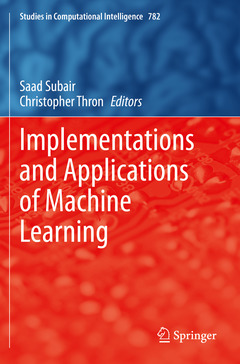Description
Implementations and Applications of Machine Learning, 1st ed. 2020
Studies in Computational Intelligence Series, Vol. 782
Coordinators: Subair Saad, Thron Christopher
Language: English
Subjects for Implementations and Applications of Machine Learning:
Publication date: 04-2021
Support: Print on demand
Publication date: 04-2020
280 p. · 15.5x23.5 cm · Hardback
Description
/li>Contents
/li>Biography
/li>Comment
/li>
This book provides step-by-step explanations of successful implementations and practical applications of machine learning. The book?s GitHub page contains software codes to assist readers in adapting materials and methods for their own use. A wide variety of applications are discussed, including wireless mesh network and power systems optimization; computer vision; image and facial recognition; protein prediction; data mining; and data discovery. Numerous state-of-the-art machine learning techniques are employed (with detailed explanations), including biologically-inspired optimization (genetic and other evolutionary algorithms, swarm intelligence); Viola Jones face detection; Gaussian mixture modeling; support vector machines; deep convolutional neural networks with performance enhancement techniques (including network design, learning rate optimization, data augmentation, transfer learning); spiking neural networks and timing dependent plasticity; frequent itemset mining; binary classification; and dynamic programming. This book provides valuable information on effective, cutting-edge techniques, and approaches for students, researchers, practitioners, and teachers in the field of machine learning.
Introduction.- Part 1: Machine learning concepts, methods, and software tools.- Overview.- Classifying algorithms.- Support vector machines.- Bayes classifiers.- Decision trees.- Clustering algorithms.- k-means and variants.- Gaussian mixture.- Association rules.- Optimization algorithms.- Genetic algorithms.- Swarm intelligence.- Deep learning,- Convolutional neural networks (CNN).- Other deep learning schema.- Part 2: Applications with implementations.- Protein secondary structure prediction.- Mapping heart disease risk.- Surgical performance monitoring.- Power grid control.- Conclusion.
Saad Subair was born on the banks of the river Nile, a few kilometers away from the capital Khartoum He is a Professor of Bioinformatics and Computer Science at the College of Computer Studies, International University of Africa (IUA), Khartoum, Sudan. Prof. Subair obtained a BSc from the University of Khartoum, PGD, MSc (Computer Science) and PhD (Bioinformatics) from UTM, Malaysia, and an MSc in Genetics from UPM, Malaysia He is an author and/or contributing author to several books, articles, and scientific papers published in USA, Germany, Malaysia, India, and Arabia. He has been Keynote Speaker in numerous regional conferences. Prof. Subair is a member of scientific and academic committees in multiple universities in the Gulf region including Princess Nourah bint Abdulrahman University at Riyadh, KSA. Prof Subair has trained hundreds of students in the fields of machine learning and bioinformatics, and has supervised and/or advised several research students who have achieved further successes in the UK and USA.
Christopher P. Thron is Associate Professor of Mathematics at Texas A&M University of Central Texas. Previously he spent a dozen years in the semiconductor industry as a systems engineer for NEC, Motorola, Freescale, and NXP. Besides consulting for various companies, Dr. Thron has obtained 3 Fulbright visiting professor fellowships and 3 U.S. Air Force faculty fellowships. He has conducted workshops and seminars in mathematical/machine learning software in several countries in Africa, as well as for the U.S. Army’s Operational Test Command. Dr. Thron’s research focuses on mathematical and statistical modeling in multiple areas of industrial mathematics, including operations research, signal processing, epidemiology, public health, and physics. He holds nine U.S. patents, and has published over 30 peer-reviewed articles.
Presents practical, useful applications of machine learning for practitioners, students, and researchers
Provides hands-on tools for a variety of machine learning techniques
Covers evolutionary and swarm intelligence, facial and image recognition, deep learning, data mining and discovery, and statistical techniques




